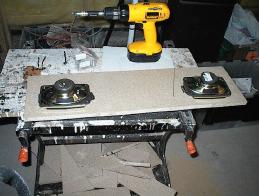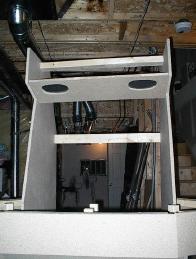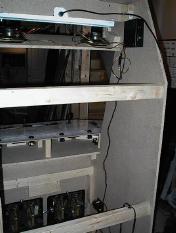| Sean McVeigh's MAME
Cabinet Project see MAMEWorld to figure out what on earth I'm talking about |
|
| Introduction Design Cabinet Controls Interfacing PC Guts Audio Video Links |
Audio I'm hoping I can scavenge an old SoundBlaster 16 from around the house. I think the older models still had power amps built in to drive external speakers, and not the wimpy line-out that most modern cards sport. Failing that, I can always build a 2-channel amp, or just pay the $15 to buy a proper one. If you missed it the first time, here are the speakers:  and again, here they are mounted in the cabinet:  These are 6x4" 8-ohm speakers. I found them at Princess Auto for $3 each. I'm not sure what their rated power output is, but I don't intend to drive them much higher than 5-10 watts. So I wound up paying the $15 and buying a small stereo amplifier. I'm not sure what the rated output on this thing is, but it has an on-off/volume knob on it so I can select whatever output level seem reasonable.  So I get this thing home and try to find a 12VDC power supply to run it when I notice the lettering above the power jack reads 12 VAC. Well, everyone knows that a wall power-supply that outputs DC has to have an AC stage in it, right? I started to disassemble an old AT power supply to tap the 12VAC side of the transformer, when I noticed an old halogen lamp sitting in one of my junk boxes. This is one of those lamps where the transformer is in a sealed base, and 2 metal rods extend up to where the lamp head sits. Unbeknownst to me, the designers of this lamp decided to forego safety, and run the conductors up the center of those rods in insulated wiring. Instead they just ran the power directly into the metal rods. One day a few years back I had discovered this design flaw while reaching around the lamp with a screwdriver and accidentally shorting out the two rods. Luckily, the transformer was fused. After removing the transformer from the base, and the blown fuse, I connected it directly to the 12VAC input on the amplifier, and it works nicely. I should probably find a fuse to put in series there some time, but that will have to wait until my next trip to the store, or to Ian's desk at work (the fans and power systems guy).  You can see the power supply sitting near the bottom of the cabinet, behind the coin doors, and the amp up next to the speakers. The connector for the speakers was a 4-pin header that managed to mate up nicely with the female header used to provide power to 3-1/2" floppy drives in a PC. The line-level inputs are female RCA-type jacks, so the standard 1/8" stereo Y-cable will connect this directly to the line-out port of my sound card. ...more... |